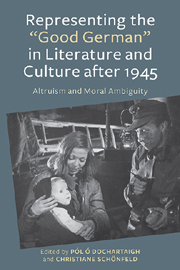Book contents
- Frontmatter
- Contents
- List of Illustrations
- Acknowledgments
- Introduction: Finding the “Good German”
- 1 Re-Presenting the Good German: Philosophical Reflections
- 2 “Görings glorreichste Günstlinge”: The Portrayal of Wilhelm Furtwängler and Gustaf Gründgens as Good Germans in the West German Media since 1945
- 3 From Hitler's Champion to German of the Century: On the Representation and Reinvention of Max Schmeling
- 4 Wilhelm Krützfeld and Other “Good” Constables in Police Station 16 in Hackescher Markt, Berlin
- 5 The “Good German” between Silence and Artistic Deconstruction of an Inhumane World: Johannes Bobrowski's “Mäusefest” and “Der Tänzer Malige”
- 6 Saints and Sinners: The Good German and Her Others in Heinrich Böll's Gruppenbild mit Dame
- 7 Being Human: Good Germans in Postwar German Film
- 8 “The Banality of Good”? Good Nazis in Contemporary German Film
- 9 Memories of Good and Evil in Sophie Scholl — Die letzten Tage
- 10 Deconstructing the “Good German” in French Best Sellers Published in the Aftermath of the Second World War
- 11 Macbeth, Not Henry V: Shakespearean Allegory in the Construction of Vercors's “Good German”
- 12 A Good Irish German: In Praise of Hugo Hamilton's Mother
- 13 Shades of Gray: The Beginnings of the Postwar Moral Compromise in Joseph Kanon's The Good German
- Works Cited
- Filmography
- Notes on the Contributors
- Index
9 - Memories of Good and Evil in Sophie Scholl — Die letzten Tage
Published online by Cambridge University Press: 05 June 2013
- Frontmatter
- Contents
- List of Illustrations
- Acknowledgments
- Introduction: Finding the “Good German”
- 1 Re-Presenting the Good German: Philosophical Reflections
- 2 “Görings glorreichste Günstlinge”: The Portrayal of Wilhelm Furtwängler and Gustaf Gründgens as Good Germans in the West German Media since 1945
- 3 From Hitler's Champion to German of the Century: On the Representation and Reinvention of Max Schmeling
- 4 Wilhelm Krützfeld and Other “Good” Constables in Police Station 16 in Hackescher Markt, Berlin
- 5 The “Good German” between Silence and Artistic Deconstruction of an Inhumane World: Johannes Bobrowski's “Mäusefest” and “Der Tänzer Malige”
- 6 Saints and Sinners: The Good German and Her Others in Heinrich Böll's Gruppenbild mit Dame
- 7 Being Human: Good Germans in Postwar German Film
- 8 “The Banality of Good”? Good Nazis in Contemporary German Film
- 9 Memories of Good and Evil in Sophie Scholl — Die letzten Tage
- 10 Deconstructing the “Good German” in French Best Sellers Published in the Aftermath of the Second World War
- 11 Macbeth, Not Henry V: Shakespearean Allegory in the Construction of Vercors's “Good German”
- 12 A Good Irish German: In Praise of Hugo Hamilton's Mother
- 13 Shades of Gray: The Beginnings of the Postwar Moral Compromise in Joseph Kanon's The Good German
- Works Cited
- Filmography
- Notes on the Contributors
- Index
Summary
In the past six decades of German cultural memory, the figure of Sophie Scholl has undergone a series of metamorphoses. She has developed from being a traitor and a suicidal failure into a distant, legendary heroine. Today, her story of resistance against the Nazi regime and her iconic and tragically fatal act of scattering seditious leaflets in the University of Munich atrium is heroically retold in classrooms throughout Germany. Placing Scholl in the context of historiographical development since her execution in 1943, this essay intends to look at how director Marc Rothemund has further modified the shape of Sophie Scholl with his film Sophie Scholl — Die letzten Tage (2005; Sophie Scholl — The Final Days). Fred Breinersdorfer, the screenwriter of the film, claims he was initially reluctant to write the script because he could only see Scholl as that distant historical figure, “jemand der immer auf einem Sockel steht, nach der Schulen benannt sind” (someone who is always on a plinth and whom schools are named after). This distance from the revered historic hero is, however, exactly what the film has succeeded in transforming.
This chapter presents an analysis of how the film normalizes its hero, not only to move beyond the previous generation's glorification of heroes, but furthermore to allow modern audiences to experience history as viscerally as possible. Using Sophie Scholl and her interrogator Robert Mohr as examples of representative “good” and “bad” Germans, this chapter will comment on the relationship between cinematic experience, memory, and authenticity. Here, specific notions of memory such as cultural memory, prosthetic memory, and postmemory will prove to be of use.
- Type
- Chapter
- Information
- Representing the "Good German" in Literature and Culture after 1945Altruism and Moral Ambiguity, pp. 151 - 169Publisher: Boydell & BrewerPrint publication year: 2013



